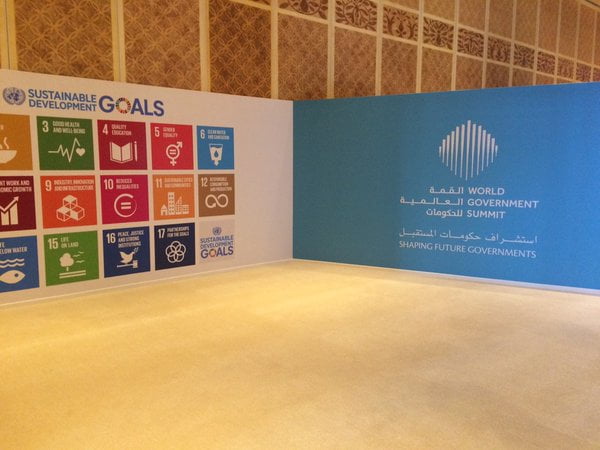(Dubai, UAE) — I’m coming to you from the World Government Summit. This is a three day conference, hosted by the government of Dubai, dedicated to discussions about the technologies and ideas that will shape the future of government and public policy. In some respects, it is a cross between TED Talks and Davos. Futurists pronounce on “disruption” while pacing around a podium with cordless mics. Heads of state and various dignitaries sit down for moderated panel discussions with television personalities doing their best to break news on stage. There are lots of “networking breaks.”
But this is also one of the first major international summits since the Sustainable Development Goals came into force on January 1 this year. And it’s clear that the advent of the SDGs are having an effect on the kinds of substance, tenor and even culture of these kinds of international conferences.
The SDGs are everywhere at this conference. And they are being meaningfully engaged.
This is the fourth year of the World Government Summit. It comes just six weeks after the Sustainable Development Goals entered into force. These, of course, are the set of 17 international targets, including the eradication of extreme poverty, that heads of state pledged to achieve by 2030.
The SDGs were formally adopted in September at the UN summit, to great fanfare. But a key question was always whether or not governments would take concrete steps to make them a reality. If the World Government Summit is any indication, it seems that governments are in fact committed. “This is one of the first occasions in which we are speaking about how to transfer this on a national level,” said Deputy Secretary General Jan Eliasson, who spent two days here.
Throughout the conference, the SDGs were a central convergence point for many of the discussions. This included planning meetings devoted to specific SDGs. “In these sessions, it was not just among people who are part of the UN or international financial systems. We had businesses, NGOs and philanthropists,” said the United Arab Emirates minister for International Development and Cooperation Sheikha Lubna Al Qasimi. “We came up with some suggestions going forward.” She cited particular discussions about monitoring and evaluation of progress toward the goals, and announced that future World Government Summits would “provide a platform to measure progress toward the goals.”
A Cultural Shift


From an international diplomatic perspective, the SDGs are valuable here precisely because they have provided a common point of reference for discussions about climate change, sustainability and a human empowerment. The hosts must have recognized that you can’t convene a “future of government”conference without confronting the broader international implications of national (or even municipal) trends. The SDGs offered a ready-made (albeit brand new) rubric through which to interpret these trends.
“The border line between international and national is disappearing,” said Jan Eliasson. “There is a cultural change happening. In order to deal with these challenges you need to involve agriculture and transportation ministries. You need to involve finance ministers. These used to be classically regarded as internal issues,” he said. “I have never seen so many finance ministers since 2015!”
The World Government Summit was the first real test for the SDGs. It’s been only six weeks since they entered into force, and the fact that this meeting is happening in a region beset by conflict and turmoil could provide an easy excuse for participants and organizers to relegate discussions about sustainable development to the back burner.
The fact that they have been so fully embraced augurs well for their potential to become more deeply and firmly engrained the fabric of international diplomacy.
